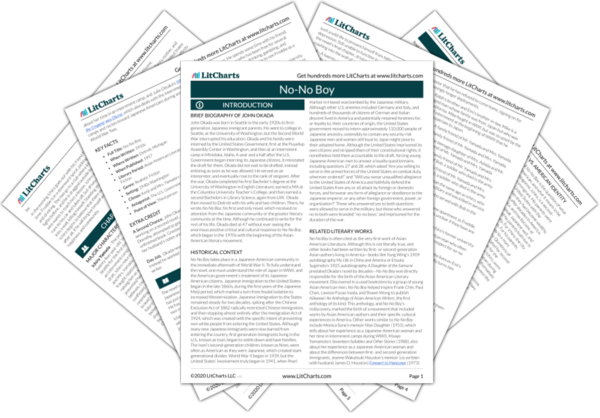Ichiro encounters a young Japanese-American waiter in a restaurant in Portland who is wearing a discharge pin on his shirt. This pin most explicitly means that the young man was honorably discharged from the United States military, and, during the war, it would have signaled that, although he was not fighting in the army, he had tried to. The pin serves as proof that this man is a veteran, and that he served his country, but the pin disturbs Ichiro. Although he understands the young man’s desire to prove that he has earned his place in America, he also knows the pin is only necessary because the young man looks Japanese, and he knows he will not be respected or treated as an American unless he has additional evidence of his dedication to his home. Ichiro is upset that the young man feels the need to assert himself this way. He believes every person should be treated with kindness and respect, and that if a person believes America is their home, others should accept this and treat them as citizens. Additionally, Ichiro is upset that Japanese Americans are having their Americanness questioned. After being discriminated against and sent to internment camps, although the majority of people had done nothing wrong, many young men were still loyal enough to America to enter its army. Despite this—being told they were not American, and then risking their lives for America—many men of Japanese descent still have their loyalty called into question. Ichiro recognizes that this sense that Japanese people are un-American is not based in fact or logic, instead, it is based in white supremacy and racism, and the belief that true Americans look a certain way, and immigrated only from certain countries.
Discharge Pin Quotes in No-No Boy
Where is the place that they talk of and paint nice pictures of and describe in all the homey magazines? Where is that place with the clean, white cottages surrounding the new, red-brick church with the clean, white steeple, where the families all have two children, one boy and one girl, and a shiny new car in the garage and a dog and a cat and life is like living in the land of the happily-ever-after? Surely it must be around here someplace, someplace in America. Or is it just that it’s not for me? Maybe I dealt myself out, but what about that young kid on Burnside who was in the army and found it wasn’t enough so that he has to keep proving to everyone who comes in for a cup of coffee that he was fighting for his country like the button on his shirt says he did because the army didn’t do anything about his face to make him look more American? … Even Mr. Carrick. Why isn’t he in? Why is he on the outside squandering his goodness on outcasts like me? Maybe the answer is that there is no in. Maybe the whole damned country is pushing and shoving and screaming to get into someplace that doesn’t exist, because they don’t know that the outside could be the inside if only they would stop all this pushing and shoving and screaming, and they haven’t got enough sense to realize that.










